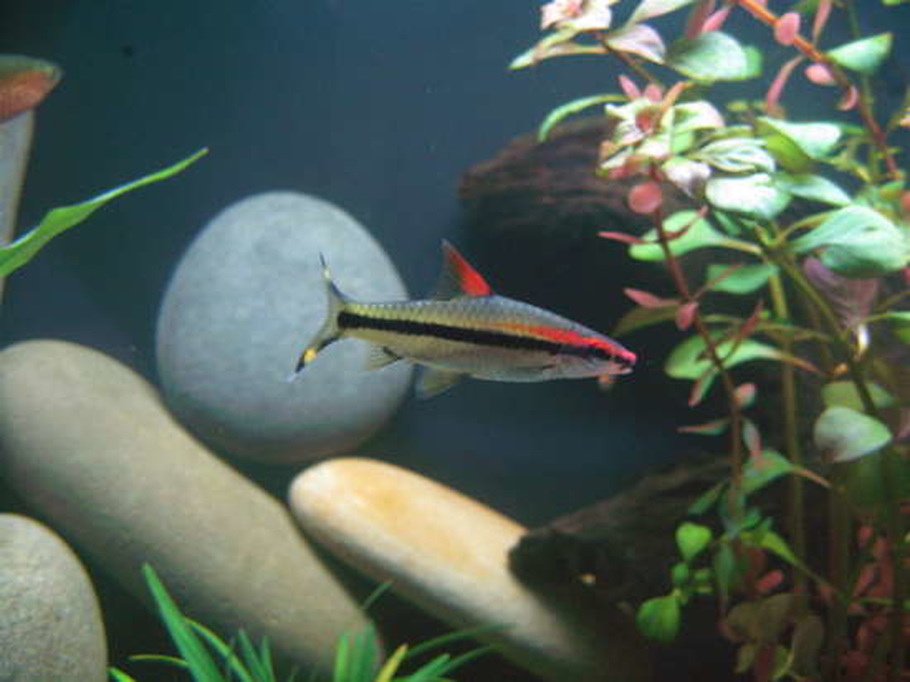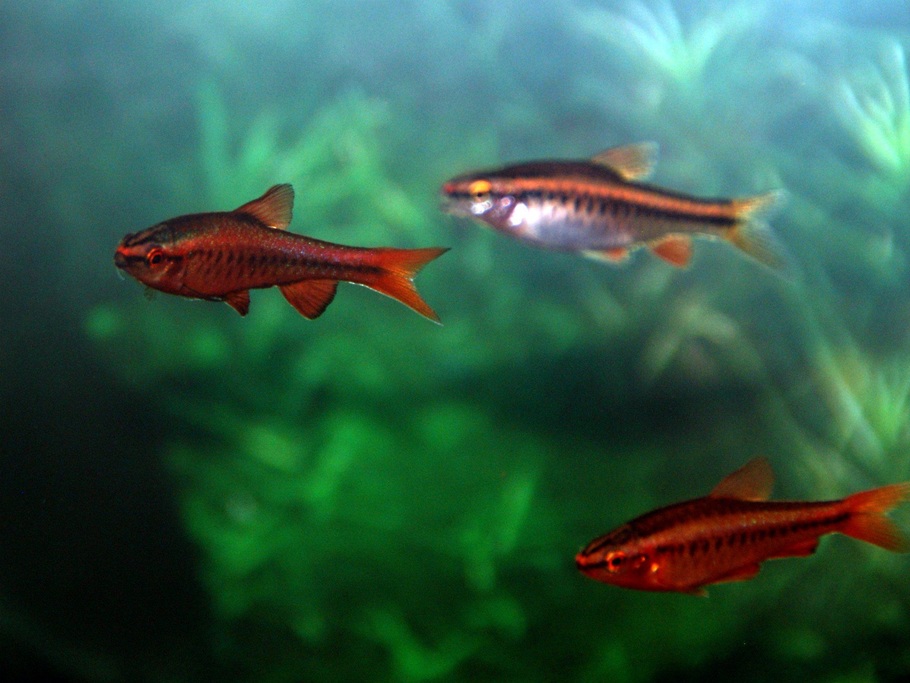CHOOSING THE RIGHT BARBS FOR YOUR TANK

Updated
Barbs are incredibly popular among freshwater aquarium hobbyists and there are a number of species to choose from. Read more to decide which species is right for you!
When it comes to stocking the freshwater aquarium, you have a great many options to choose from. If you visit your local pet store you may be overwhelmed by the number of options available – even more so if you shop for aquarium fish online. If you have absolutely no idea where to start in stocking your tank, barbs are a great option. There are many species of barb to choose from and several are very popular in the aquarium hobby. These fish tend to do well in community tanks and they are not particularly difficult to keep in the home aquarium. If you think that barbs might be a good fit for you and your aquarium, read more to learn about the different species.
About Freshwater Barbs
Barbs belong to the family Cyprinidae which is the same family to which minnows, carps and goldfish belong. This family of fishes contains over 2,000 species with 194 genera, but not all barbs are popular in the aquarium hobby. One example is the giant barb (Catlocarpio siamensis), native to Thailand, which grows up to 9 feet long. The most popular species are those which do not get too large and which exhibit bright colors. Many barb species exhibit bright colors on the fin as well as vertical or horizontal striping along the body.
Barbs can be found throughout the world, but they are predominantly native to Southeast Asia. The most popular species are widely bred by commercial breeders both in the US and oversees which makes them fairly easy to find. While many species of barb get along well in community tanks, some tend to be semi-aggressive. To prevent aggressive behaviors, it is best to keep these fish in groups with six or more of their own species. These fish also tend to be jumpers, so it is important to keep a tight-fitting lid on the aquarium.
corals inverts - echinophyllia sp. - chalice coral stocking in 37 gallons tank

State: Maryland
Country: United States
MORE INFO
Photo Caption:
Tyree LE Robokaki Chalice
Fish Kept:
1-Banghaii Cardinal, 1-Firefish goby, 1-six-line wrasse, 1-yellow watchman goby, 1-painted clown goby, 1-green chromis, 1-pygmy hawk.
Corals/Plants:
2-Acans (1 red, 1 green)
2-Monti Cap (1 orange, 1 green)
1-Green Psammacora
1-Acro sp.
1-Duncan w/new head
1-Blasto wellsi w/3 new heads
1-Candy Cane
1-Robokaki Chalice
1-Alien Eye Chalice
1-Galaxia (it was on the bottom got bumped by the mag cleaner and all but died...my bad not checking it's location after the bottom relocation)
1-Green Favia
1-kenyan tree softie
2-Neon Green Sinularia
1-Green Polyped Leather
12+ assorted colored Ricordea
4+ hairy mushrooms
2 Metallic green elephant ears
2-Red Rhodactis
5 or 6 Green Rhodactis
Many different color Discsomas
Many different color Zoanthids
2 species Pulsing Xenia
Electric Green Colve polyps that have orange tips
Daisy Cloves
Micro blue cloves
Orange Gorgonian (captive frag doing good so far)
INVERTS~
6-8 blue leg hermits
2-peppermint shrimp
1-Scarlet cleaner shrimp
1-growing brittle star ( came as a hitchhiker)
Tank Size:
37 gallons

Tank Requirements and Care
Specific tank requirements may vary slightly from one species to another but, for the most part, barbs are hardy fish. It is always a good idea to mimic the natural habitat of your fish as much as you can in your aquarium – this will ensure that your fish have the best chance they can get of thriving in captivity. The ideal tank setup for barbs would include a variety of live plants including floating plants – floating plants will help dim the lighting in your tank, reducing the likelihood that your barbs will be shy. Barbs also appreciate the addition of rock caves and driftwood in their tanks to provide hiding places. Though decorations are important in a tank for barbs, it is crucial that you do not overcrowd the tank because barbs like to have plenty of space for swimming.
The exact water temperature and pH value of your tank may vary depending which species of barb you choose, but most barbs have similar requirements for water parameters. Generally, barbs prefer neutral to slightly acidic pH values. These fish are able to tolerate variations in water parameters, but they are unlikely to do well in poor water quality. It is important to perform weekly water changes of 10% to 15% of the tank volume as well as monthly water changes of 20% to 25%. Equipping your tank with a high-quality filtration system and aquarium heater is also very important.
Barb Species
One of the most popular species of barb, and also one of the most popular species of freshwater aquarium fish, is the tiger barb. These fish grow to about 2 ½ inches long and they exhibit silver bodies with red coloration on the fins and bold black stripes running vertically down their bodies. Tiger barbs are very active and they are best kept in schools with others of their kind – this is the best way to prevent them from becoming aggressive in community tank environments. Though these fish can be peaceful, they should not be kept with slow-moving or long-finned fishes – better tank mates would include loaches, cories, platies and red-tailed sharks.
Another popular species of barb is the rosy barb. These fish are named for their pinkish-red coloration – they also exhibit black-tipped fins and a black spot on the tail. Rosy barbs grow up to 5 inches in length and they are available in both long-finned and regular form. These fish are very hardy by nature and they tend to tolerate cooler temperatures than many freshwater fish – they can be kept in water ranging from 68 to 72°F. Like tiger barbs, cherry barbs should be kept in schools but they are not as boisterous as tiger barbs.
Cherry barbs are another very popular species and they are one of the most well-behaved species of barbs. These fish tend to grow up to 2 inches in length and they exhibit reddish coloration with an iridescent hue. This species prefers to be kept in dim lighting with calm tank mates. Unlike some species, cherry barbs are still widely collected in the wild but there is a danger of overfishing in Sri Lanka. These fish have no special tank requirements and they would do well in a tank similar to that of tiger or rosy barbs.

If none of these barb species strikes your fancy, consider one of the other barb species listed below:
Gold Barb – The gold barb is named for its bright gold coloration and it is a small species, remaining about 3 inches long at most. This species is very easy to care for and peaceful in the community tank, though it does require a tank size of 30 gallons minimum. The gold barb is omnivorous, feeding on a variety of commercial flakes and pellets as well as live, frozen, or freeze-dried foods.
Snakeskin Barb – If you are looking for a species of barb with a unique appearance, the snakeskin barb is a great option. This species only grows to about 2 inches long and it has a beautiful orange/red coloration with dark green splotches that mimic the look of snakeskin. This species is semi-aggressive so it needs to be kept in large schools with others of its own kind to limit aggression toward other species.
Denison Barb – The Denison barb is a large species, growing to a length around 4 ½ inches. This species is silver in color with a dark black line running the length of its body – it also has a red stripe running across the eyes and about halfway down the body. The Denison barb is an omnivorous species and generally peaceful, though it does require a large tank due to its size.
Hexagon Barb – The hexagon barb is a very small species, only growing to about 2 inches in length. This species is very peaceful and easy to care for, though it does best in groups with 5 or more of its own species. The hexagon barb is omnivorous and it breeds fairly easily in the home tank.
There are a great many species of barbs to choose from in addition to these three but tiger, rosy and cherry barbs are three of the most popular. If you are new to the aquarium hobby and just don’t know where to start, any of these three species would be a great choice.
comments powered by Disqus







































































































































